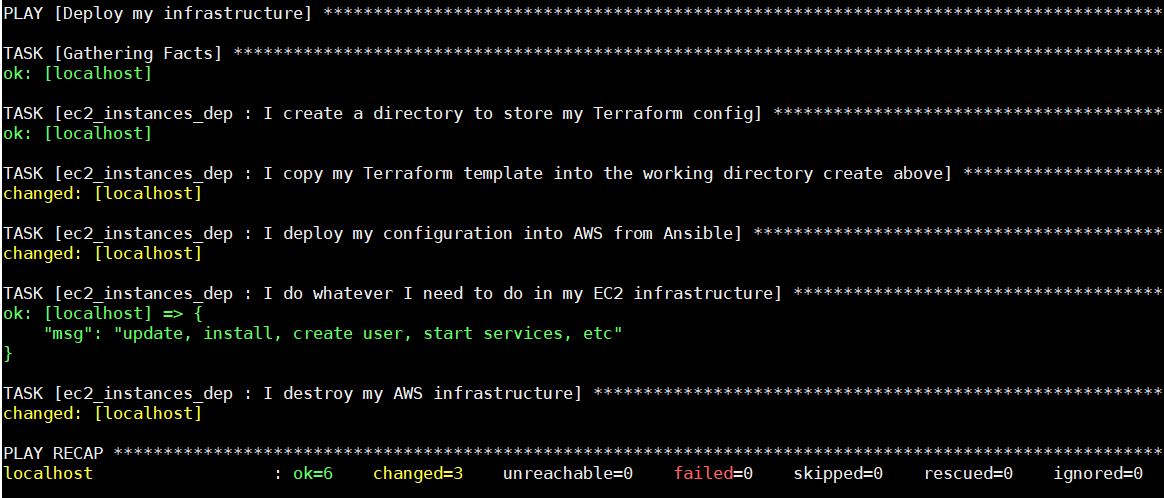Automate AWS deployments with Ansible + Terraform
This installation is made from a bastion server already available with the proper network permissions.
For different deployment types, you should adapt it to your need.
Install requirements
Ansible installation:
sudo apt update
sudo apt install -y software-properties-common
sudo apt-add-repository --yes --update ppa:ansible/ansible
sudo apt install -y ansible
Terraform installation:
wget https://releases.hashicorp.com/terraform/0.12.24/terraform_0.12.24_linux_amd64.zip
sudo unzip -d /usr/local/bin/ ./terraform_0.12.24_linux_amd64.zip
ref: https://www.techrepublic.com/article/how-to-install-terraform-on-ubuntu-server/
AWS Client installation:
curl "https://awscli.amazonaws.com/awscli-exe-linux-x86_64.zip" -o "awscliv2.zip"
unzip awscliv2.zip
sudo ./aws/install
ref: https://docs.aws.amazon.com/cli/latest/userguide/install-cliv2-linux.html
Connect your environment to your AWS cloud
$ aws configure
AWS Access Key ID [None]: AKIAIOSFODNN7EXAMPLE
AWS Secret Access Key [None]: wJalrXUtnFEMI/K7MDENG/bPxRfiCYEXAMPLEKEY
Default region name [None]: eu-central-a
Default output format [None]: json
ref: https://docs.aws.amazon.com/cli/latest/userguide/cli-chap-configure.html#cli-quick-configuration
Create a new Ansible project
That is my favorite Ansible layout. The one I’ve seen as the best so far:
mkdir -p ~/my_aws_project/inventory
mkdir -p ~/my_aws_project/playbooks
mkdir -p ~/my_aws_project/roles
Add the EC2 dynamic inventory
Ansible can work with a different kind of inventory called the dynamic inventory.
Instead of having a static declaration in a static file of your inventory, you can generate it from a source.
This source can be a database, an active directory, etc. A dynamic inventory is a scrip that outputs a JSON in a structure that Ansible can handle. We could then develop a script that discovers our EC2 infrastructure that would take some time. Or we can use the one already provide with Ansible:
Install prerequisites:
sudo apt install -y python3-pip
sudo pip3 install boto
sudo pip3 install ansible
sudo rm /usr/bin/python
sudo ln -s /usr/bin/python3 /usr/bin/python
Get the EC2 dynamic inventory:
wget -O ~/my_aws_project/inventory/ec2.py \
https://raw.githubusercontent.com/ansible/ansible/stable-2.9/contrib/inventory/ec2.py
wget -O ~/my_aws_project/inventory/ec2.ini \
https://raw.githubusercontent.com/ansible/ansible/stable-2.9/contrib/inventory/ec2.ini
chmod +x ~/my_aws_project/inventory/ec2.py
There are multiple configuration options you can do with the ini file. For this blog I’ll change those vars:
regions = eu-central-1
vpc_destination_variable = private_ip_address
Test the inventory script:
~/my_aws_project/inventory/ec2.py ## ---> return JSON description of your AWS infrastructure
Because I want to work on one AWS region in the private network only. Since my bastion is already in
the AWS infrastructure.
Add a role for our deployment
I’ll create a role with the only purpose to deploy my infrastructure into AWS.
ansible-galaxy init --init-path ~/my_aws_project/roles ec2_instances_dep
Cable the components (Ansible configuration)
To have that layout working fine and the simpliest way, I use that configuration:
## file ~/my_aws_project/ansible.cfg
[defaults]
roles_path = ./roles
inventory = ./inventory/ec2.py
Test the ansible inventory:
cd ~/my_aws_project
ansible-inventory --graph ## ---> return the Ansible interpreted inventory
Terraform with Ansible
When I need to do something with Ansible, I first check in the list of modules is the work is already done.
And, nicely, there is a module for Terraform.
So I can add this module in my task main file of my role:
## ~/my_aws_project/roles/ec2_instances_dep/tasks/main.yml
---
- name: I create a directory to store my Terraform config
file:
path: "~/aws_terraform"
state: directory
recurse: yes
- name: I copy my Terraform template into the working directory create above
template:
src: "my_ec2_infra.tf"
dest: "~/aws_terraform/my_ec2_infra.tf"
- name: I deploy my configuration into AWS from Ansible
terraform:
project_path: "~/aws_terraform"
force_init: true
state: "present"
register: r_aws
- name: I do whatever I need to do in my EC2 infrastructure
debug: msg="update, install, create user, start services, etc"
- name: I destroy my AWS infrastructure
terraform:
project_path: "~/aws_terraform"
state: "absent"
Terraform content
Add this file into the template directory: ~/my_aws_project/roles/ec2_instances_dep
## file ~/my_aws_project/roles/ec2_instances_dep/my_ec2_infra.tf
provider "aws" {
region = "eu-central-1"
}
resource "aws_instance" "dba-essential" {
count = "5"
ami = "ami-0e342d72b12109f91"
availability_zone = "eu-central-1a"
instance_type = "t2.micro"
associate_public_ip_address = false
security_groups = ["my_sg_01"]
vpc_security_group_ids = ["sg-602eff2724d52a0b7"]
key_name = "my_key_01"
root_block_device {
delete_on_termination = true
encrypted = false
volume_size = 15
volume_type = "gp2"
}
tags = {
Owner = "Nicolas"
Name = "crash-test-${count.index + 1}"
}
}
Create a playbook to call the role
## file ~/my_aws_project/playbooks/deploy.yml
---
- name: Deploy my infrastructure
hosts: localhost
roles:
- ec2_instances_dep
Run the playbook
cd my_aws_project
ansible-playbook playbooks/deploy.yml
 Boom! Here it is. Now imagine that you can generate a unique key and unique directory for each deployment and you can deploy as much infrastructure as your credit card will accept it.
Boom! Here it is. Now imagine that you can generate a unique key and unique directory for each deployment and you can deploy as much infrastructure as your credit card will accept it.
I hope this helps, and please comment below for any questions.
![Thumbnail [60x60]](https://www.dbi-services.com/blog/wp-content/uploads/2022/12/oracle-square.png)
![Thumbnail [90x90]](https://www.dbi-services.com/blog/wp-content/uploads/2024/01/HME_web.jpg)
![Thumbnail [90x90]](https://www.dbi-services.com/blog/wp-content/uploads/2022/11/NIJ-min-scaled.jpg)
![Thumbnail [90x90]](https://www.dbi-services.com/blog/wp-content/uploads/2022/08/JEW_web-min-scaled.jpg)